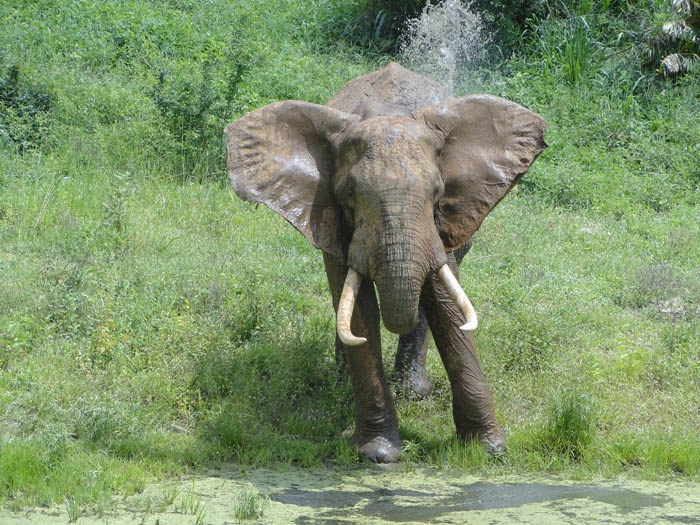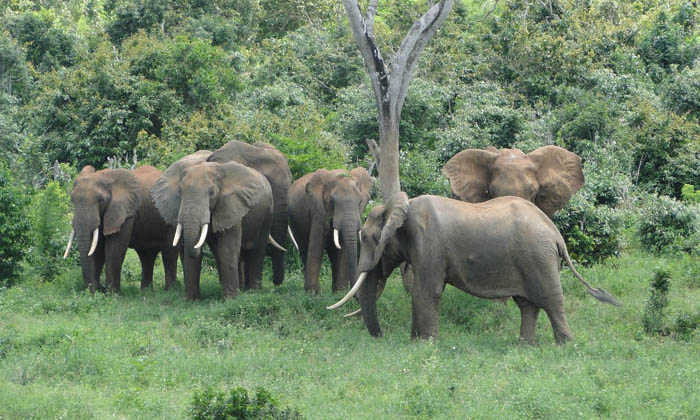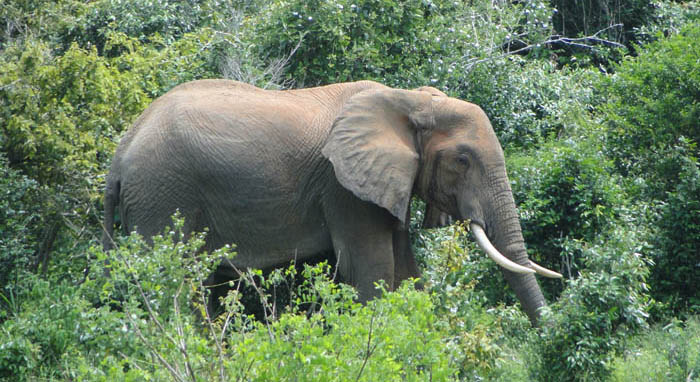THE ELEPHANTS
Elephants are the big attraction at Mwaluganje, and there are plenty of them here, about 150 individuals. As you drive through the Sanctuary, you may notice that the elephants here are predominantly bulls. Mwaluganje is historically a bull area where independent elephant bulls grow in preparation for the demanding life of breeding males.
 You can sit for hours and watch the fascinating life of these African elephants. You may see a huge bull demolish a tree by tearing it apart with his tusks, behaviour considered quite normal for an elephant, and a necessary one for a healthy forest ecosystem. By destroying trees and shrubs, these huge herbivores clear areas for grasses to grow that other smaller species eat closer to the forest floor. They also help seed germination through their digestive process. Elephants have an uncanny ability to locate underground water and dig pools which provide many other species with water during droughts.
You can sit for hours and watch the fascinating life of these African elephants. You may see a huge bull demolish a tree by tearing it apart with his tusks, behaviour considered quite normal for an elephant, and a necessary one for a healthy forest ecosystem. By destroying trees and shrubs, these huge herbivores clear areas for grasses to grow that other smaller species eat closer to the forest floor. They also help seed germination through their digestive process. Elephants have an uncanny ability to locate underground water and dig pools which provide many other species with water during droughts.
By the Manolo River, whole groups of elephants can disappear underwater in the stream, or take an enthusiastic group mud bath. If you are lucky enough to spot family groups in the area, you might see big bulls courting the females or fighting with competitors. Young elephants are fun to watch, especially when they take to chasing their peers and rolling on top of one another. Elephant calves take pleasure in also chasing warthogs and tumbling in the dirt and mud. You will be surprised at how similar elephant behaviour is to that of fun-loving humans.
 The elephant families in the Sanctuary use neighbouring areas in the Shimba Hills Reserve, Dimbula Forest and Mwaluganje Forest to live and play. On the occasion, family groups visit males during the mating season and cross into the Sanctuary as they travel between feeding areas.
The elephant families in the Sanctuary use neighbouring areas in the Shimba Hills Reserve, Dimbula Forest and Mwaluganje Forest to live and play. On the occasion, family groups visit males during the mating season and cross into the Sanctuary as they travel between feeding areas.
 Once or twice a year several related elephant families come together and move as one unit of up to 200 female calves or all ages. This is a sight to remember. These aggregations usually originate in the Shimba Hills and move into Mwaluganje during the raining season (December, March and April). Such large herds only last for three to four days and are a rare and magnificent sight to see. Like human families at a reunion, whenever elephant family members or friends meet, they celebrate these gatherings with noisy greetings. This is usually observed when a friend or family member is absent for a long time. An incredible welcoming takes place when they return in which the elephants spin around, defecate and urinate. With their heads held high, and ears flapping they fill the air with a symphony of trumpets, rumbles, screams and roars.
Once or twice a year several related elephant families come together and move as one unit of up to 200 female calves or all ages. This is a sight to remember. These aggregations usually originate in the Shimba Hills and move into Mwaluganje during the raining season (December, March and April). Such large herds only last for three to four days and are a rare and magnificent sight to see. Like human families at a reunion, whenever elephant family members or friends meet, they celebrate these gatherings with noisy greetings. This is usually observed when a friend or family member is absent for a long time. An incredible welcoming takes place when they return in which the elephants spin around, defecate and urinate. With their heads held high, and ears flapping they fill the air with a symphony of trumpets, rumbles, screams and roars.







